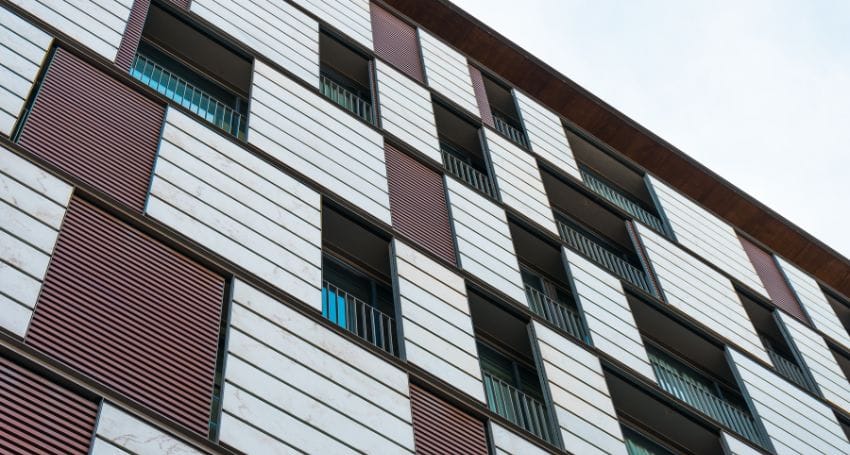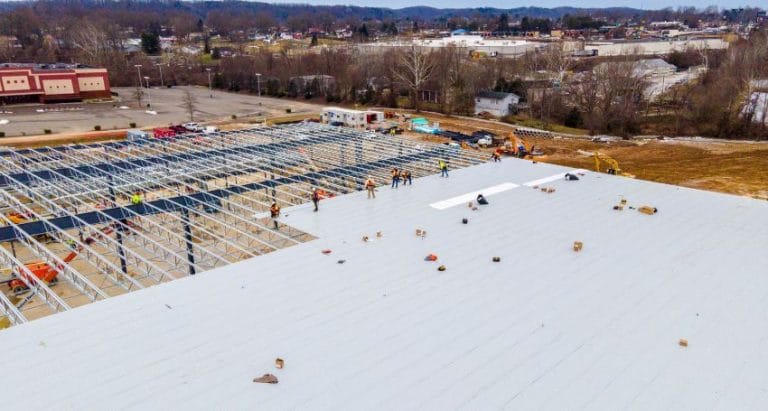If you’ve ever admired the clean, modern exterior of a contemporary building, chances are you’ve seen rainscreen cladding at work. This advanced wall system is designed not only to enhance aesthetics but also to protect buildings from rain, wind and moisture damage, while improving energy efficiency and longevity.
At Zinc & Copper Works, we specialise in providing premium metal rainscreen cladding systems that perfectly balance performance and architectural appeal.
Understanding Rainscreen Cladding Systems
So, what is rainscreen cladding exactly? In simple terms, it’s a protective outer layer fixed to a building’s exterior, forming a barrier against weather exposure. However, unlike traditional type of cladding, a rainscreen cladding system incorporates a ventilated cavity between the external panels and the inner wall.
This cavity allows air to circulate behind the cladding, enabling any trapped moisture to drain away and evaporate, keeping the main structure dry. The typical system consists of three layers:
- External cladding panels: Often crafted from zinc, copper, aluminium, timber, or stone.
- Ventilated air cavity: Promotes drying and balances air pressure.
- Weather-resistant barrier (WRB): Acts as a secondary defence against water ingress.
In essence, a rainscreen wall system serves as both a shield and a breathing layer, ensuring that buildings remain dry, insulated, and energy-efficient throughout the year.
How Does Rainscreen Cladding Work?
The science behind how rainscreen cladding works lies in the pressure balance and ventilation it creates. When rainwater penetrates through the joints of the outer panels, the cavity behind allows it to drain or evaporate naturally.
The weather-resistant barrier prevents any residual moisture from reaching the structural wall, while the air gap equalises pressure between the exterior and interior surfaces, reducing water penetration, a concept known as pressure equalisation.
This clever design ensures effective moisture control in buildings, prevents mould or rot, and improves thermal insulation for buildings, leading to enhanced comfort and reduced energy costs.
Types of Rainscreen Cladding
There are several types of rainscreen cladding, each suited to different design preferences and performance requirements:
- Open-Joint Rainscreen Systems: Features visible joints between panels, allowing continuous airflow and rapid drying.
- Closed-Joint Rainscreen Systems: Panels interlock or overlap, providing superior water resistance while maintaining ventilation.
- Drained and Back-Ventilated Systems: The most common configuration, combining efficient drainage with airflow for maximum protection.
Each type can be tailored using a range of rainscreen cladding materials such as metal, fibre cement, terracotta, or timber to achieve the desired appearance and functionality.
Rainscreen Cladding Materials
Selecting the right rainscreen cladding materials is key to durability, performance, and aesthetics. Here are some of the most popular options:
- Zinc and Copper: Premium metals known for their timeless appearance and self-healing patina.
- Aluminium: Lightweight, corrosion-resistant, and available in a variety of finishes.
- Fibre Cement: A cost-effective option with excellent durability and fire resistance.
- Terracotta or Ceramic: Natural finishes offering texture and colour variation.
- Timber: Provides a warm, sustainable look when treated for longevity.
At Zinc & Copper Works, we specialise in zinc and copper rainscreen cladding systems, designed to age beautifully while offering long-term performance and minimal maintenance.
Benefits of Rainscreen Cladding
The benefits of rainscreen cladding go far beyond weather protection. It’s a multi-functional system that enhances a building’s performance and sustainability:
- Superior Moisture Protection: Prevents water damage, dampness, and mould growth.
- Enhanced Thermal Efficiency: Improves insulation, reducing heating and cooling costs.
- Weather Resistance: Shields the structure from harsh environmental conditions.
- Low Maintenance: The ventilated design reduces dirt build-up and corrosion.
- Sustainability: Many metals, such as zinc and aluminum, are recyclable and eco-friendly.
- Extended Lifespan: Protects the underlying structure, reducing repair needs.
- Aesthetic Flexibility: Offers unlimited design options to suit contemporary or traditional architecture.
Ready to protect your building with a modern, weatherproof façade? Contact us today for expert advice on rainscreen cladding systems.
Installing Rainscreen Cladding
Installing rainscreen cladding requires technical precision to ensure correct ventilation, drainage, and alignment. The general process involves:
- Preparing the Substructure: Creating a secure framework to support the panels.
- Applying the Weather-Resistant Barrier: Providing secondary moisture protection.
- Fixing the Panels: Using mechanical fixings or clips for secure attachment.
- Detail Finishing: Ensuring proper sealing at corners, joints, and openings.
Experienced specialists like Zinc & Copper Works follow best practices to ensure every installation meets performance and design standards.
Sustainable Rainscreen Cladding
As the construction industry shifts towards greener practices, sustainable rainscreen cladding has become a preferred choice. Using recyclable materials such as zinc, copper, and aluminium supports eco-friendly construction while reducing long-term maintenance waste.
These metals also develop a natural protective layer over time, enhancing durability and extending their life expectancy, often beyond 50 years. Sustainable systems not only reduce environmental impact but also offer lasting value for property owners.
Looking for high-quality, sustainable rainscreen façade systems? Get in touch with Zinc & Copper Works, your trusted experts in metal cladding and façades.
Frequently Asked Questions (FAQs)
1. What is the main purpose of rainscreen cladding?
Rainscreen cladding protects buildings from rain and moisture while improving ventilation, insulation, and energy efficiency.
2. How does rainscreen cladding improve building performance?
By creating an air cavity, it allows moisture to escape and enhances thermal regulation, extending the lifespan of the structure.
3. What materials are best for rainscreen cladding?
Metals such as zinc, copper, and aluminium are ideal due to their strength, durability, and low maintenance.
4. Can rainscreen cladding be used on any type of building?
Yes, it is suitable for both commercial and residential buildings, offering flexibility in design and installation.
5. Does rainscreen cladding require much maintenance?
Not much. Occasional cleaning and inspection are enough to maintain performance and appearance for decades.




